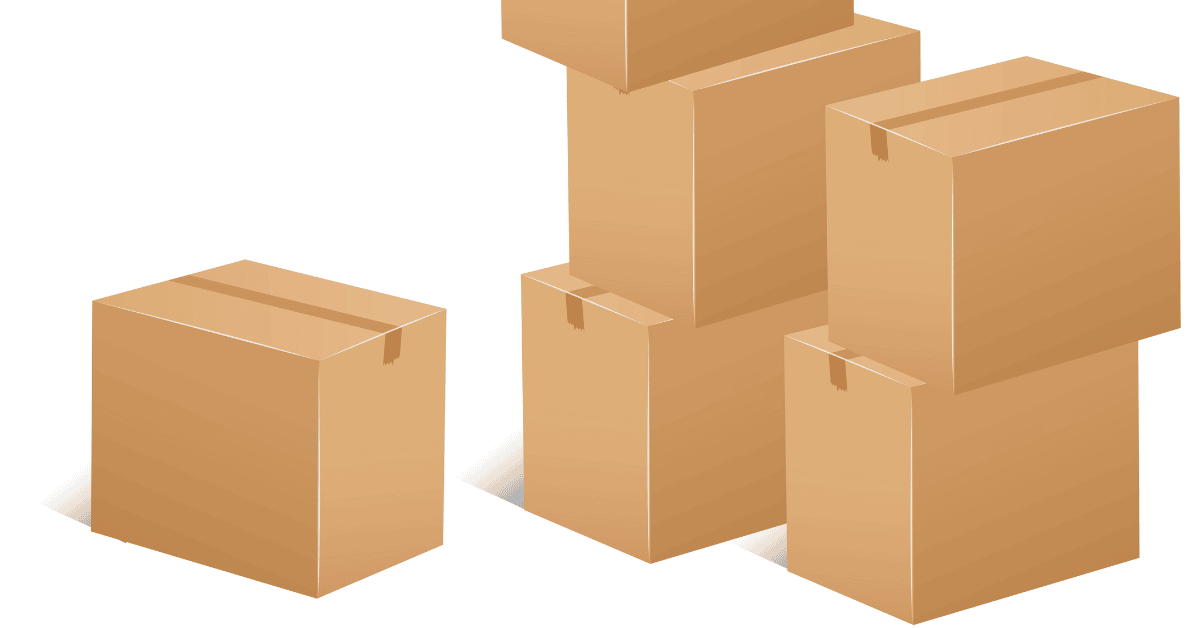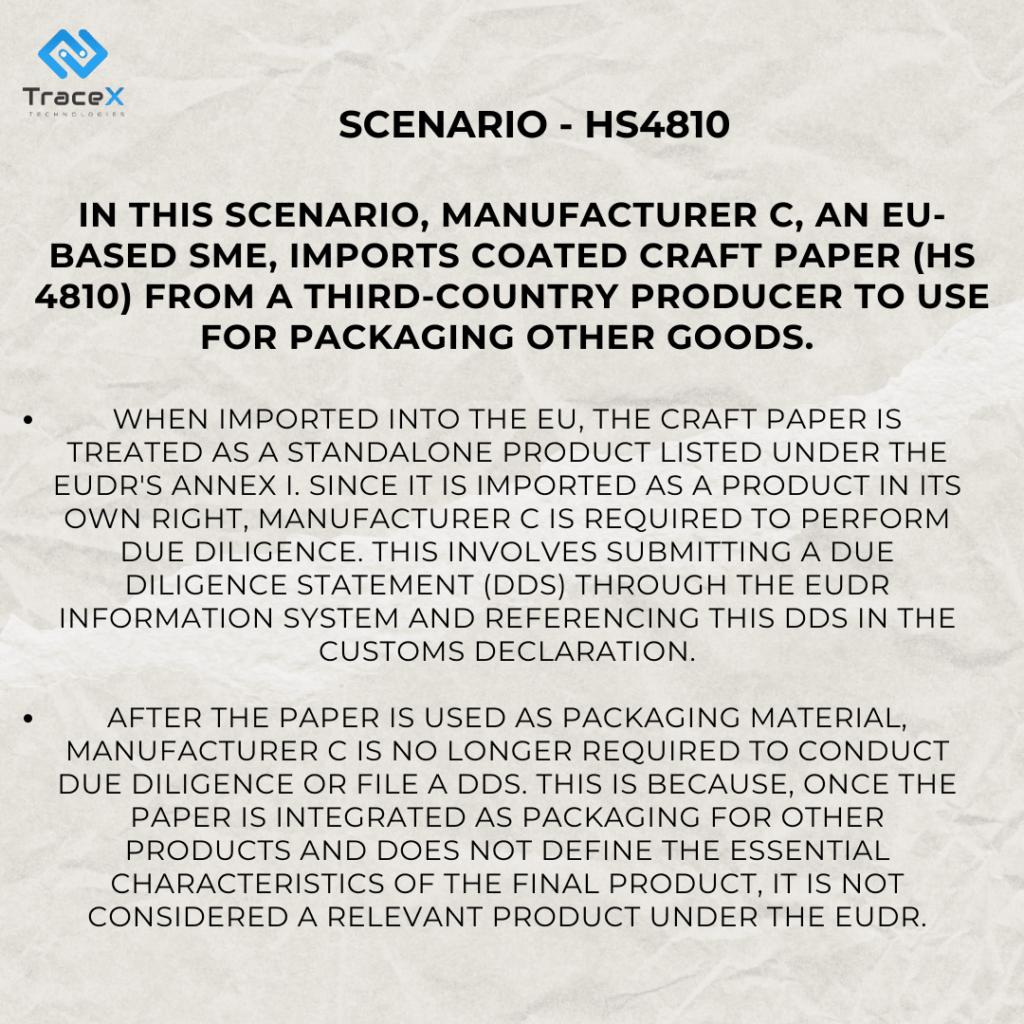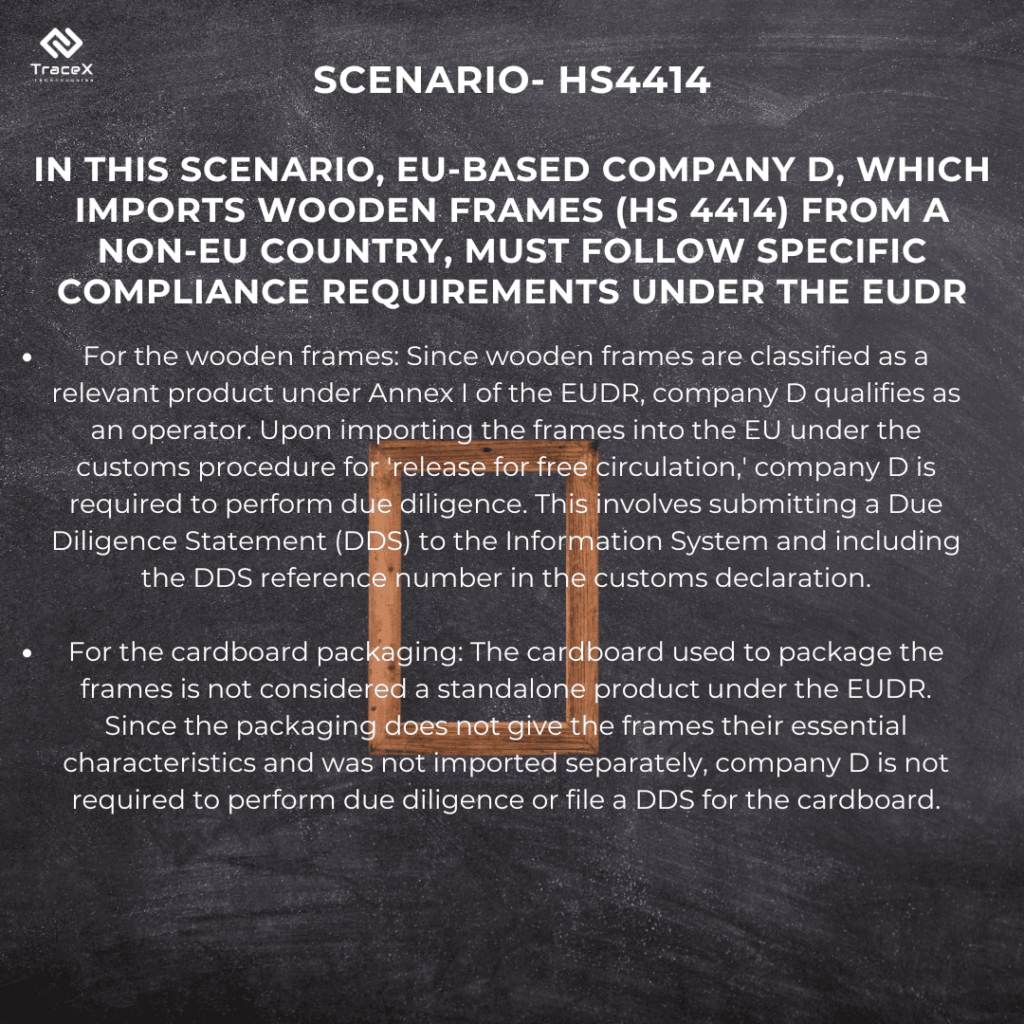Contact: +91 99725 24322 |
Menu
Menu
Quick summary: Understand the EUDR packaging requirements and what’s covered or exempt under the new European Union Deforestation Regulation. Learn how to comply with due diligence, especially for packaging materials like paper and cardboard.

What’s covered under EUDR packaging and what’s not, ensures your company stays compliant and sustainable. When it comes to packaging and the EUDR (European Union Deforestation Regulation), many businesses are left wondering how far the regulations extend. While the focus has largely been on agricultural commodities like soy, palm oil, and cocoa, packaging materials used in transporting or housing these products may also fall under scrutiny. Does your packaging meet the new deforestation-free requirements?
Packaging is often an overlooked aspect when it comes to regulatory compliance, but with the introduction of the European Union Deforestation Regulation (EUDR), businesses can no longer afford to ignore its impact. Many companies are now grappling with questions like: Does my packaging material fall under the EUDR scope? Or, How do I ensure that my packaging choices align with deforestation-free requirements?
Key Takeaways
The European Union Deforestation Regulation (EUDR) is part of the EU’s strategy to combat global deforestation and forest degradation. Its goal is to ensure that products entering or being exported from the EU market do not contribute to deforestation. Companies must provide proof that their products, including relevant commodities and associated goods, are sourced from deforestation-free supply chains.
While many people are familiar with the regulation’s implications for commodities like palm oil, beef, and soy, there’s often confusion around its application to packaging materials. In the context of the European Union Deforestation Regulation (EUDR), understanding the scope of the products affected can be tricky, especially when it comes to packaging materials. The regulation, which aims to prevent deforestation linked to the production of certain goods, is very specific in its definitions and classifications, particularly when it comes to packaging.
The EUDR classifies goods based on their Harmonized System (HS) code, a global standard for identifying goods. Two main HS codes relevant to packaging materials fall under the purview of the EUDR: HS Code 4819 and HS Code 4415. But the regulation’s applicability depends on how the packaging is being used.

HS Code 4819 includes items such as cartons, boxes, cases, bags, and other packing containers made of paper, paperboard, or cellulose fibers. If these items are placed on the market or exported as products in their own right, they fall under the EUDR. This means that if you’re selling decorative gift boxes or paperboard packaging without any goods inside, the EUDR requirements apply. These products must be sourced from deforestation-free materials, and you’ll need to conduct due diligence to prove compliance.
Imagine you’re a European company selling customized gift boxes made of paperboard. These gift boxes are the product itself, not a means to package other goods. In this case, your gift boxes would be subject to the EUDR’s deforestation-free requirements, and you would need to provide geolocation data or other documentation proving that the paperboard used in the boxes does not originate from deforested areas.
On the other hand, if these same paperboard cartons are used only as packing material to support, protect, or carry another product (for example, if they are used to ship electronics or food products), they are not covered by the EUDR. This means the regulation does not apply to packaging used solely for transportation or protection during transit.
If a company ships electronics in paperboard cartons classified under HS Code 4819, the cartons themselves wouldn’t need to meet EUDR standards unless they are sold separately as standalone products.
HS Code 4415 covers wooden packing materials, such as packing cases, boxes, crates, pallets, and drums made of wood. Similar to HS Code 4819, if these wooden materials are placed on the market or exported as products in their own right, they fall under the EUDR. This includes items like wooden crates or pallets sold to businesses for shipping purposes.
Suppose a company sells custom wooden crates to transport delicate machinery. Since the crates are the primary product being sold (even though they’re used for transport), they are subject to EUDR regulations. You would need to ensure the wood used for these crates comes from non-deforested areas.
Wooden packing materials used solely to support or protect another product are not subject to the EUDR. This means wooden pallets used for shipping products, for example, are excluded if they are not the primary product being sold.
If wooden pallets are used to transport goods like electronics or food, but are not being sold as a standalone product, they wouldn’t need to comply with EUDR.

Packaging materials are only regulated under the EUDR if they are placed on the market as products themselves. This distinction is key to understanding the scope of your obligations. In some cases, packaging materials that give a product its essential character can be classified as part of the product.
For instance, decorative packaging like gift boxes that are integral to the product would be considered under EUDR compliance, while standard shipping packaging would not.
The Combined Nomenclature provides additional clarity through General Rule 5, which helps distinguish between packaging that is subject to the EUDR and packaging that is not. It identifies two types of packaging:
Example: A decorative wooden gift box for jewelry would be covered by the EUDR if it is sold as part of the product.
Example: A wooden crate used to ship machinery is not subject to EUDR because it’s only meant to protect the goods during transport.
These rules, however, only apply to a small percentage of goods, and businesses must ensure they classify their products correctly to avoid penalties.
There are several scenarios where packaging materials are not subject to EUDR regulations:
It’s crucial for businesses to know these distinctions to avoid unnecessary compliance efforts.
The EUDR places significant responsibility on companies to prove that their supply chains are deforestation-free and impacts global trade. Failing to comply can result in penalties and legal risks, not to mention potential damage to your business’s reputation. If you’re in the packaging industry or use packaging materials in your products, it’s essential to understand when these materials are regulated under the EUDR.
Under the EU Deforestation Regulation (EUDR), publishing companies must ensure that all packaging materials—from book covers to shipping cartons—are sourced from deforestation-free, traceable origins. This means meeting strict EUDR packaging requirements to secure EU market access and build trust with sustainability-conscious readers and retailers.
By ensuring compliance, you not only avoid these risks but also position yourself as a leader in sustainability—something that modern consumers value more than ever.
To comply with the EUDR, companies need to conduct thorough due diligence. This includes gathering documentation like geolocation data to prove that the raw materials used in their products (or packaging) are sourced from deforestation-free areas. Working with certified suppliers, conducting risk assessments, and using platforms that provide traceability and transparency are all essential strategies.
One way to streamline this process is by adopting traceability platforms like TraceX, which offer blockchain-based solutions for tracking and verifying supply chains. With TraceX, you can ensure compliance with the EUDR while promoting trust and transparency with your customers.
The TraceX EUDR compliance platform can greatly assist packaging companies in navigating EUDR compliance by providing end-to-end traceability solutions.
1. Automated Due Diligence: The platform helps packaging companies streamline the due diligence process by tracking the entire supply chain of raw materials, ensuring that they are sourced sustainably and meet EUDR standards. This includes identifying whether materials like paper or wood used in packaging are subject to EUDR requirements.
2. Real-Time Data: Packaging companies can access real-time, verifiable data on the origin of materials, ensuring that they comply with regulations around deforestation-free sourcing.
3. Compliance Reporting: TraceX simplifies the process of generating and submitting Due Diligence Statements (DDS), making it easier for packaging companies to file accurate reports with regulatory authorities, reducing administrative burden.
4. Risk Assessment: The platform offers tools to assess the risk of non-compliance in the supply chain, helping companies proactively address any potential issues.
By using TraceX’s platform, packaging companies can ensure their products meet EUDR requirements, avoid penalties, and demonstrate a commitment to sustainability.
The EUDR is a landmark regulation in the fight against global deforestation, and it places significant responsibilities on businesses. Understanding when packaging materials fall under its scope is crucial for compliance. By staying proactive, you can turn regulatory challenges into opportunities for growth and sustainability.
Packaging materials explicitly listed in Annex I of the EUDR, such as coated craft paper (HS 4810) and wood-based packaging (HS 4414), are subject to due diligence. These materials must comply if imported as independent products into the EU.
Cardboard packaging materials used solely for packaging purposes and not sold as standalone products are generally not covered under EUDR. For example, cardboard used to package goods is exempt, as it doesn’t give the final product its essential characteristics.
Operators importing packaging materials classified as relevant products must conduct due diligence and file a Due Diligence Statement (DDS). However, when these materials are used solely for packaging, they may be exempt, simplifying compliance processes.
